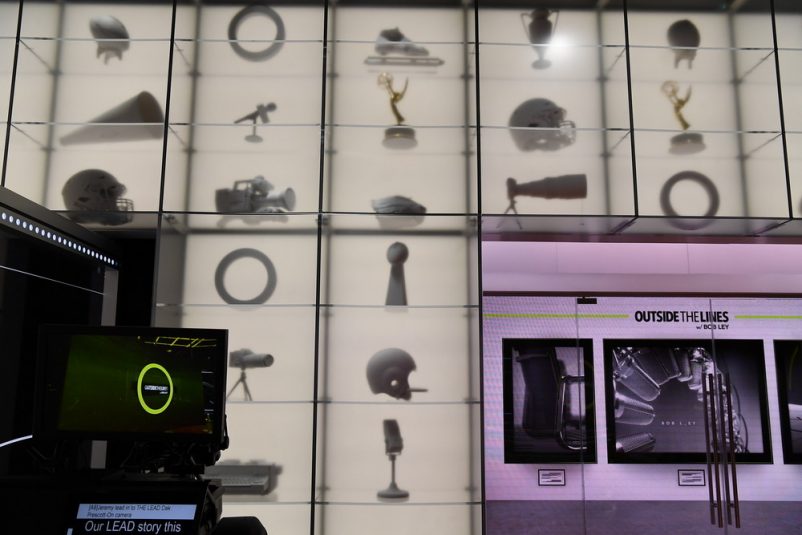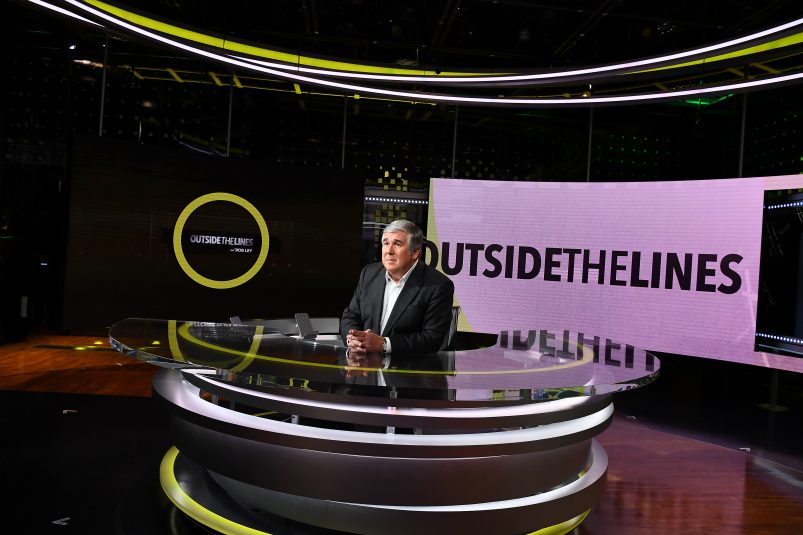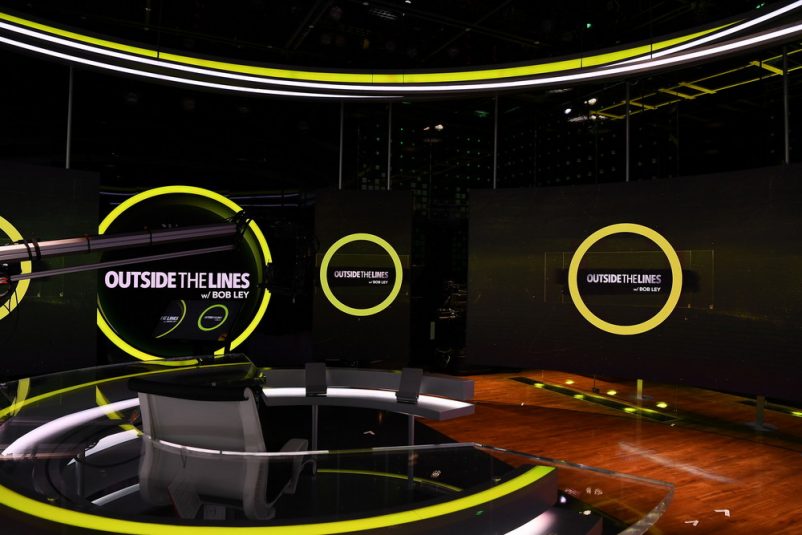ESPN Harnesses the Power of Storytelling in Design of Studio Z
The network’s newest studio, designed in the round, is home to Outside the Lines and E:60
Story Highlights
ESPN has expanded its commitment to storytelling, giving Outside the Lines and E:60 permanent, year-round slots on the broadcast schedule and a new home in a state-of-the-art studio in Digital Center 2 (DC2). Studio Z, which makes its television debut this weekend, houses both shows — Outside the Lines at 1 p.m. ET weekdays, E:60 at 9 a.m. Sundays — and gives a larger, more prominent stage to acclaimed journalists Bob Ley and Jeremy Schaap.
“ESPN has long sought a home base where our famed storytellers can provide in-depth storytelling wrapped in a powerful language supported by inspiring photography and video,” says Dan Cunningham, creative director, set design, ESPN. “ESPN’s Studio Z, which is in our Digital Center 2, located on our Bristol, CT, campus, is our home for storytelling. And that is something that ESPN has wanted for a very long time. We’ve shared studios for various shows that tell stories, and we wanted a dedicated place.”
When DC2 opened three years ago, it did so with a few open studio spaces that could be filled at a later date. One of the smaller studio spaces proved ideal for the needs of both Outside the Lines and E:60 and has been transformed into Studio Z. The European-inspired studio will use different color palettes to differentiate between the two shows. It was designed in the round “to make possible wrapping our stories around the storyteller,” says Cunningham.
“Our host desk puts Bob Ley at the nucleus, or center, of the storytelling,” he continues. “We wrapped the desk around Bob, rather than having him at the end of a table. [This] allows him to easily face different areas of the studio, interviewing in-studio guests, then turning around to address a remote interview [on] one of our displays, or turning to the viewer. Options are made easy.”
Architectural elements and aesthetics provide depth to the space and visual interest to the viewers. Numerous stand-up areas, each with a customizable background, give Ley and Schaap various places from which to tell their stories. The studio itself has both dark and light areas, which lend a fitting look and feel to subject matter that is darker or more lighthearted in tone.
The rounded studio features a variety of LED display technology provided by AV Design Services. AVDS outfitted the space with magnetic LED tiles manufactured by DesignLED in sizes from 1.9 mm to 2.5 mm and flexible enough to match the curve of the studio. Studio Z houses a fixed main display, three different-size movable displays suspended from above the set, and a variety of support displays built into the architecture. The displays can be combined to act as one or separated to play individual content.
“We tried to get away from the 16:9 television ratio that you usually see in studios. 16:9 is easy to produce in rapid fashion, but we’ve tried to break away from that and go with almost odd-size displays,” Cunningham explains. “The thought was to try to give a unique ratio when giving our graphic designers options, and they can connect [the displays] for one extremely wide graphic or separate. Really, the whole purpose is to support storytelling.”
A PTZ camera suspended from a circular track above and surrounding the set gives viewers a unique perspective of the show. In addition, three robotic cameras, a jib, and a second PTZ camera are suspended from the grid above the studio.

A wall displaying sports memorabilia and journalistic tools of the trade is a tribute to the history of journalism.
Throughout the design process, ESPN looked for unique ways to honor not only Ley and Schaap’s rich history of sports journalism but the history of journalism in general. An area that recognizes Ley and Schaap specifically is “the gallery”: located at the east end of the studio behind two glass doors, the customizable display area showcases past stories and photos of the two hosts.
“From the graphics side of it, we’re embracing black-and-white still photography,” notes Cunningham, “and that’s playing a key role with the success of both shows.”
To pay tribute to the history of journalism, ESPN created a wall displaying sports memorabilia — a football helmet or a speed skate — with journalistic tools of the trade, such as an announcer’s microphone or broadcast camera. The items are set behind diffused glass and lit from behind, giving them a soft white silhouette.
The design of Studio Z was spearheaded by creative leads Erik Ulfers and Emmet Aillo of Clickspring Design; set fabrication was handled by Mystic Scenic. Lighting design and implementation was done in-house by ESPN Studio Design and Development, with Chris Watson serving as lighting director.
All photos courtesy of ESPN Images


